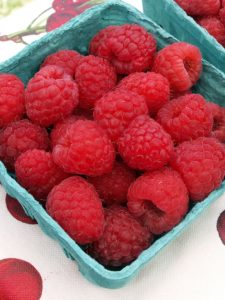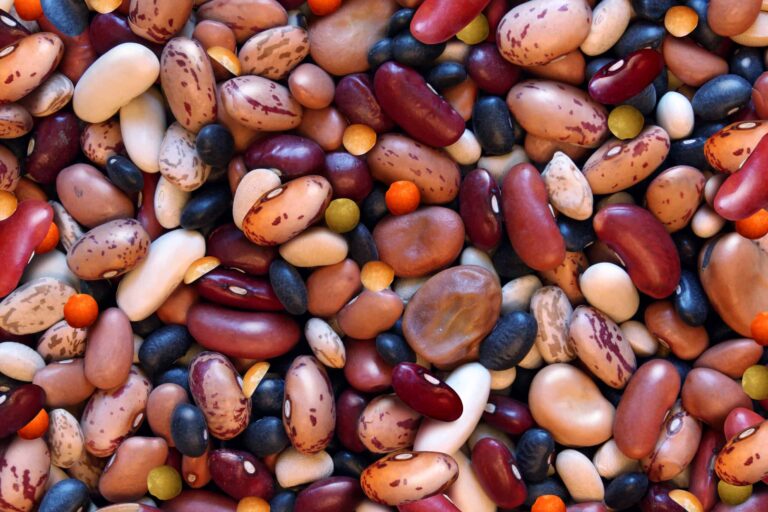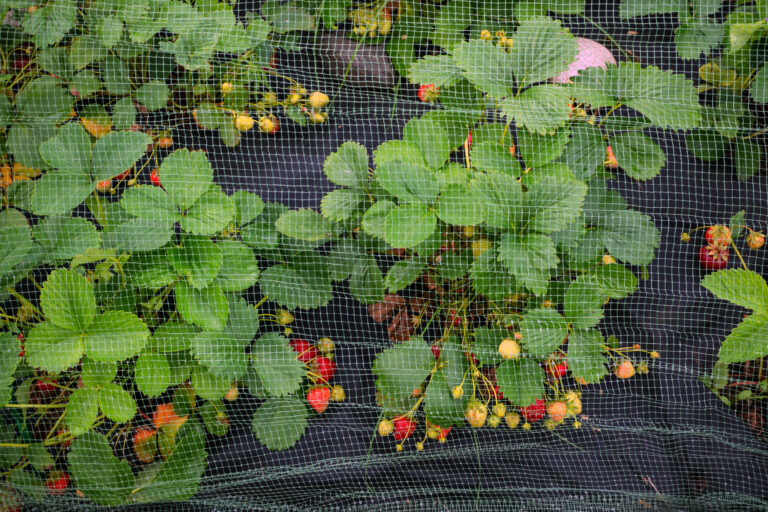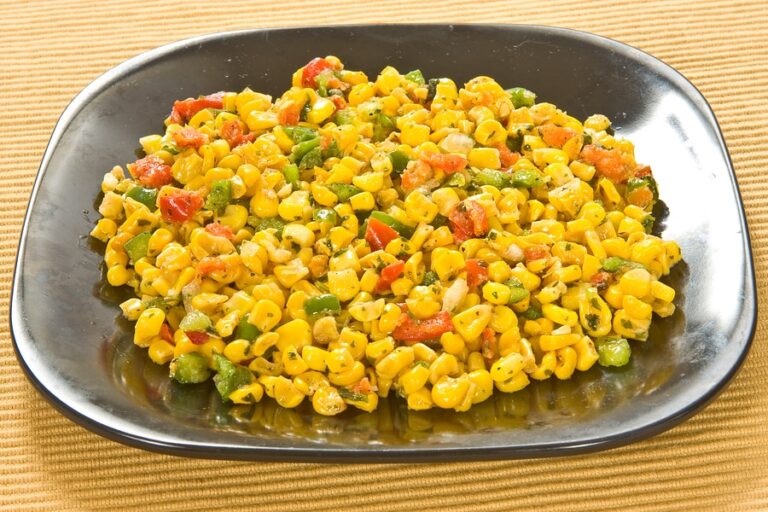Ways to Serve Raspberries
Raspberries are the most intensely flavored and delicate of berries.
The peak season for red raspberries in the Northern Hemisphere is June through September; for the golden or yellow raspberry June through October, and for the black raspberry during July.
To best experience the luscious raspberry—many consider it a finer fruit than the strawberry–be sure to choose ripe raspberries just picked. Raspberries do not ripen off the vine, so you must select plump berries that are brilliantly colored.
If you can pick your own, raspberries harvested in the morning will be sweeter and keep longer. A ripe raspberry will be sweetly tart and juicy.
The raspberry requires very careful handling; it bruises easily. It is best to simply eat the raspberry straightaway.
The golden raspberry—with a flavor similar to an apricot–is a mutant of the red raspberry. The black raspberry—which is not a blackberry—is actually blue-black and is native to North America. Black raspberries are often called blackcaps.
Ways to serve raspberries
Raspberries are best when served raw; sprinkle them with sugar and drizzle with milk or cream. Serve raspberries fresh with ice cream, sorbet, and yogurt, or used them to garnish fruit salads, cereals, cakes, and crêpes.
- Combine raspberries with sliced peaches, pears, or nectarines, and serve with chocolate sauce and sweetened whipped cream.
- Use raspberries with peaches or nectarine in cobblers and crisps.
- Purée raspberries to make a dessert sauce, and add sugar to taste. Serve with custard, mousse, pudding, sherbet, or cake. Raspberry coulis is prepared by tossing the berries in the blender and afterward passing the pulp through a sieve to remove the tiny seeds.
- Use raspberries in tarts syrups jams, jellies, compotes, and wine.
- Raspberries are interchangeable with strawberries in most recipes.
- To make a raspberry vinaigrette for a green salad or for grilled chicken: blend raspberries with white balsamic vinegar, vegetable oil, honey, rosemary, salt, and black pepper to taste.
How to choose raspberries
Select raspberries that are full, round, and meaty not flattened. A ripe raspberry will be brightly colored. A sublime raspberry will have a soft floss to it and be sweetly perfumed.
Raspberries with green caps attached are not ripe. They were picked too early.
Avoid shriveled or moldy berries and berries in containers that are too closely packed. If there are juice stains on the container, the berries may be overripe.
How to store raspberries
Raspberries will keep in the refrigerator for 1 to 2 days. Spread the berries out on a paper towel and remove any moldy berries before storing them. Do not wash raspberries until just before serving.

Raspberry flavor partners
Raspberries have a flavor affinity for champagne, chocolate, cream, framboise, honey, kirsch, peaches, pears, sour cream, sugar, and vanilla.
Raspberry nutrition
Raspberries contain iron, potassium, and vitamins A and C.
About raspberries
Raspberries grow on canes that can reach 3 to 10 feet high (.9-3 m) tall. The raspberry plant has bristly and thorny woody branches. The roots of the raspberry are perennial, but the fruit-bearing canes are biennial. Raspberries develop on canes that grew the year before, except in the case of everbearing red raspberries which set fruit on the end of their canes the first year and on the lower portion of the same cane the second year.
Canes die after fruiting, but the roots spread perpetually. Individual raspberries form in the middle of the plant’s small white flowers and become visible once the petals fall.
The individual raspberry is actually a cluster of small fruits each with its own seed. These small fruits are called drupes or drupelets. Drupelets surround a central white core. Unlike the blackberry, the collective drupelets of the raspberry pull away from the core when harvested creating a hollow center in the berry.
The name raspberry comes from raspis the old English name for raspberry. Raspis is a reference to the berry’s rough, slightly hairy surface or rasping surface. By way of comparison, the blackberry has shiny smooth skin. And for the record, loganberries and boysenberries are hybrids of the raspberry and blackberry.
All raspberries were once white—according to an ancient tale. When the nymph Ida pricked her finger while picking raspberries for the young god Jupiter, the raspberries turned red.
Modern believers of this story say it happened on Mount Ida (named after the nymph)—which is in modern-day Turkey. That explains the species name of red raspberries idaeus; the botanical name for the red raspberry is Rubus idaeus.
Red raspberries–said to be derived from Rubus idaeus–are also indigenous to North America. One of those has the botanical name Rubus odorata—which means fragrant raspberry. There are several other species of raspberry—all of them are indigenous to the cooler regions of the northern hemisphere.
The botanical name for the black raspberry is Rubus occidentalis. The botanical name of the wild American red raspberry is Rubus strigosus.
Related articles:
Planning the Home Fruit Garden
Garden Planning Books at Amazon:
- Vegetable Garden Almanac & Planner
- Kitchen Garden Grower’s Guide Vegetable Encyclopedia
- Vegetable Garden Grower’s Guide
- Tomato Grower’s Answer Book
More kitchen tips:
Bring your harvest to the table. Kitchen prep tips and easy recipes for the vegetables you grow. Click below for vegetable prep and recipes you can use now.
- Almonds
- Apples
- Apricot
- Aprium
- Artichoke
- Arugula
- Asparagus
- Avocado
- Bamboo Shoots
- Banana
- Basil
- Beans, Dried
- Beans. Long
- Beans, Shell
- Beans, Snap
- Beets
- Bitter Melon
- Blackberry
- Bok Choy
- Broccoli
- Broccoli Raab
- Brussels Sprouts
- Cabbage
- Cardoon
- Carrots
- Cauliflower
- Celeriac
- Celery
- Chard
- Chayote Squash
- Cherimoya
- Cherries
- Chestnut
- Chickpea
- Chinese Cabbage
- Chives
- Cilantro
- Citron
- Clementine
- Collards
- Coriander
- Corn, Sweet
- Corn, Baby
- Corn Salad, Mache
- Cranberry
- Cress
- Cucumber
- Daikon
- Dandelion
- Dill
- Eggplant
- Endive, Belgian
- Endive and Escarole
- Fava Beans
- Fig
- Florence Fennel
- Garlic
- Ginger
- Grapefruit
- Grapes
- Guava
- Horseradish
- Jerusalem Artichoke
- Jicama
- Jujube
- Kale
- Kiwifruit
- Kohlrabi
- Kumquat
- Leeks
- Lemongrass
- Lemons
- Lettuce
- Lime
- Mache (Corn Salad)
- Mandarin Orange
- Mango
- Maple Syrup
- Marjoram
- Melons
- Michihili
- Mint
- Mizuna
- Mushrooms
- Mushrooms, Cremini
- Mustard Greens
- Napa Cabbage
- Nectarine
- Okra
- Olives
- Olive oil
- Onions
- Oranges
- Oregano
- Parsley
- Parsley Root
- Parsnips
- Passion Fruit
- Pawpaw
- Peaches
- Pears
- Peas, Garden Snap
- Peas, Snow
- Pei Tsai
- Peppers, Chili
- Peppers, Sweet
- Persimmon
- Pineapple
- Pineapple Guava
- Plantain
- Plums
- Pluots
- Pomegranate
- Potatoes
- Prickly Pear
- Pumpkin
- Quince
- Radicchio
- Radishes
- Raspberries
- Rosemary
- Rhubarb
- Rutabaga
- Sage
- Salsify
- Sauerkraut
- Savory
- Shallots
- Sorrel
- Spinach
- Squash, Summer
- Squash, Winter
- Strawberries
- Sunchokes
- Sunflower
- Sweet Potato
- Swiss Chard
- Tangerine
- Taro
- Tarragon
- Thyme
- Tomatillo
- Tomato
- Turnip
- Turnip Greens
- Yams







